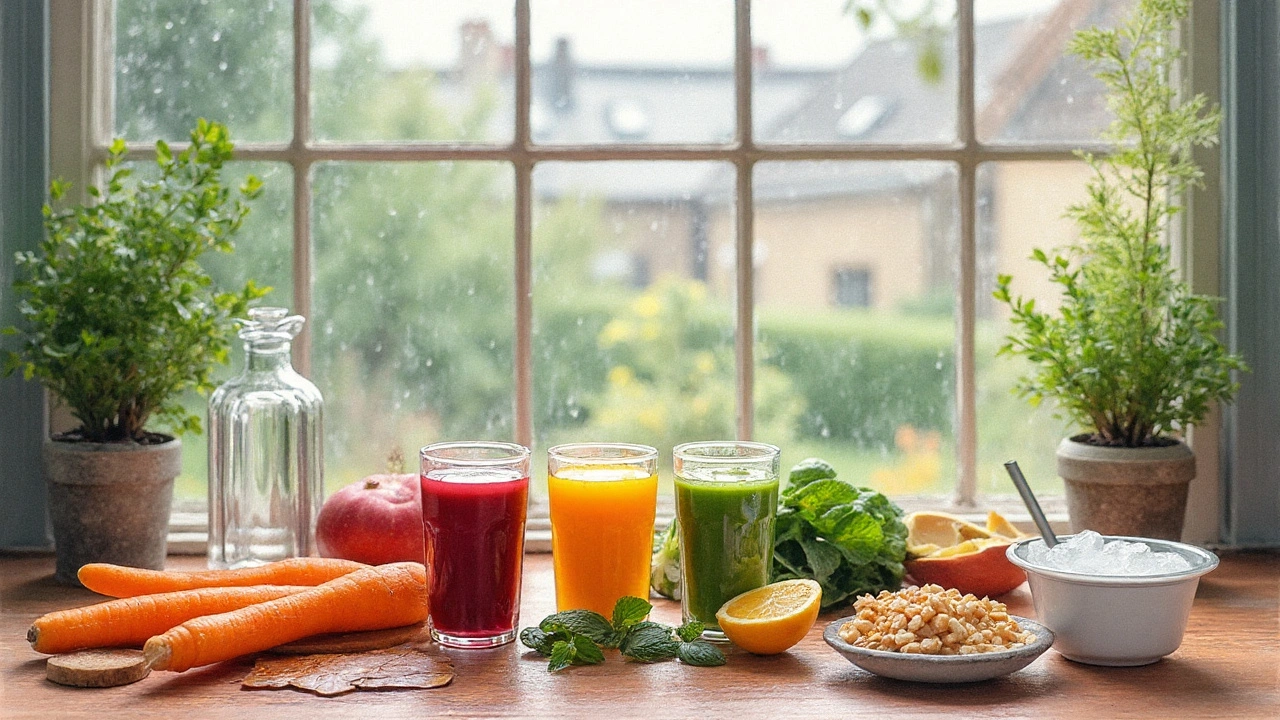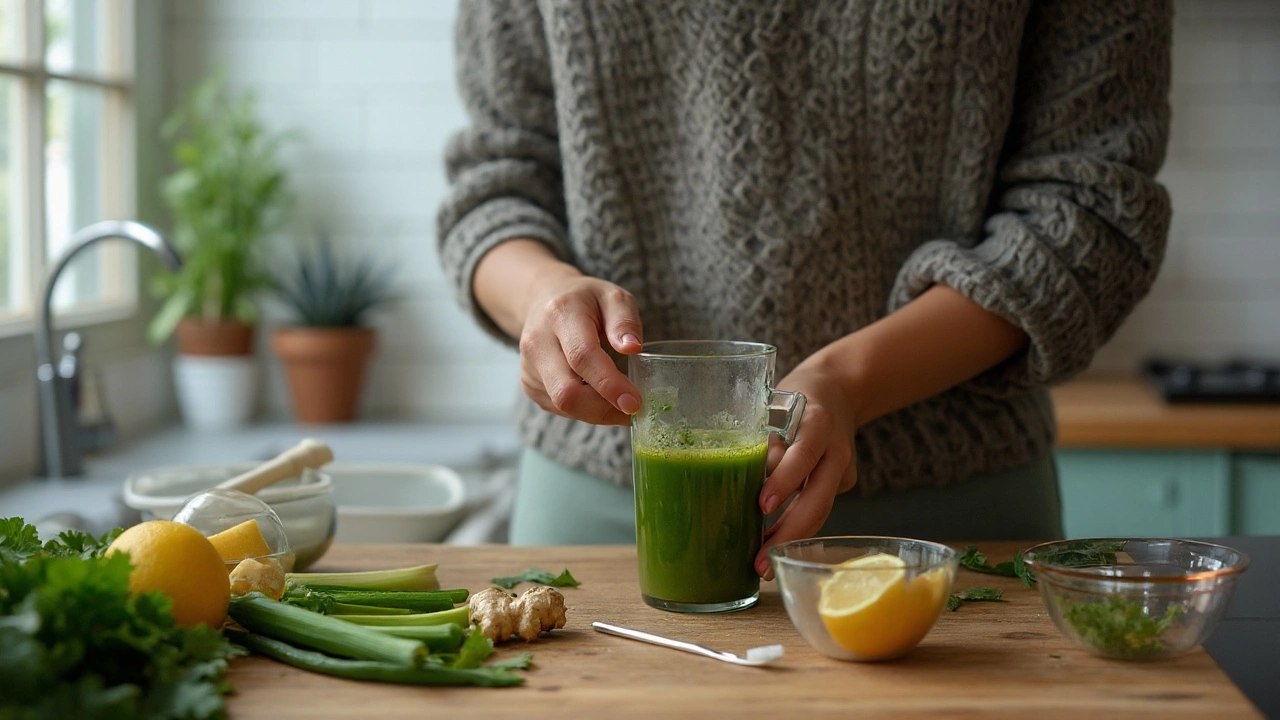You want more nutrients without chewing through a mountain of veg. Juice feels like the shortcut. It can be-if you build it right. Here’s the honest deal: juice helps you hit vitamins and minerals fast, but it’s not a fibre fix or a magic detox. Use it to complement a balanced diet, not replace it.
TL;DR - Key takeaways
- Use a veg‑first ratio (about 2-3 parts vegetables to 1 part fruit). Keep single servings to 125-350 mL depending on fruit content.
- Juice helps with vitamin C, potassium, folate, and nitrates (beet). It won’t deliver much fibre. Pair with meals or add chia to smooth the sugar curve.
- Quick build: Base (cucumber/celery), Leaf (spinach/kale), Root (carrot/beet), Citrus (lemon/orange), Boost (ginger/turmeric). Done in 5 minutes.
- Safety matters: scrub produce, chill fast, drink within 24-72 hours (cold‑pressed). At‑risk groups should avoid unpasteurised juice.
- Evidence check: 125 mL fruit juice can count as one fruit serve (NHMRC, Australia), but whole fruit is better for fibre. Large daily fruit‑only juices are linked with higher sugar intake (Harvard HSPH; BMJ cohort data).
What health juice can and can’t do
Set expectations first. A health juice is a fast way to deliver vitamins, minerals, and plant compounds in a small volume. Think vitamin C from citrus, potassium from orange/watermelon, folate from leafy greens, beta‑carotene from carrot, and dietary nitrates from beet. These help with immunity, skin health, blood pressure, and exercise performance. That’s the upside.
The limits? You strip out most fibre when you juice. Fibre feeds your gut microbes, stabilises blood sugar, and keeps you full. That’s why most national guidelines prefer whole fruit and vegetables. The Australian Guide to Healthy Eating (NHMRC) allows 125 mL of unsweetened fruit juice to count as one fruit serve, but notes it should be occasional because of low fibre. The UK NHS caps fruit juice at 150 mL per day. Harvard T.H. Chan School of Public Health and a BMJ cohort analysis have linked higher fruit juice intake (vs. whole fruit) with higher type 2 diabetes risk and weight gain over time. Translation: go small on fruit‑heavy juices and go big on vegetables.
How much is sensible? As a rule of thumb:
- Fruit‑forward juices: 125-150 mL per day, ideally with a meal.
- Vegetable‑dominant juices (2-3:1 veg to fruit): up to 300-350 mL, especially if you’re active and eat plenty of fibre elsewhere.
Timing helps too. With breakfast or a protein‑rich snack, the sugar hits slower. Post‑workout, a small juice can help replenish carbs alongside electrolytes.
For a quick reality check, here’s what common juices actually deliver per 250 mL (approximate ranges based on USDA FoodData Central and standard raw/cold‑pressed values):
| Juice (250 mL) | Sugars (g) | Vitamin C (mg) | Potassium (mg) | Fibre (g) | Notable nutrients |
|---|---|---|---|---|---|
| Orange | 20-24 | 80-100 | 450-500 | <1 | Folate, thiamin |
| Carrot | 9-13 | 5-15 | 300-350 | <1 | Beta‑carotene (vitamin A precursor) |
| Beet | 17-22 | 2-8 | 400-500 | <1 | Dietary nitrates |
| Apple | 24-28 | 0-3 | 250-300 | <1 | Polyphenols |
| Watermelon | 16-20 | 15-25 | 300-350 | <1 | L‑citrulline (small amounts) |
| Green (kale/spinach + apple) | 10-18 | 30-70 | 400-550 | <1 | Folate, vitamin K |
Note: Ranges vary with produce, season, and juicer type. If you’re managing blood sugars, potassium, or vitamin K, tailor ingredients and serving size with your clinician or dietitian.

Build a nutrient‑dense juice: step‑by‑step
This is the fast framework that keeps flavour high and sugar sensible. Think of it as a template, not a rulebook.
- Pick your base (1-2 cups): Cucumber or celery for hydration and volume with minimal sugar. They help your juicer grab enough liquid to pull through leafy greens.
- Add a leaf (1 cup packed): Spinach for folate and mild flavor. Kale for a bit more bite and vitamin K. Silverbeet/chard works too. Rotate your greens to vary nutrients.
- Choose a root (1 medium): Carrot for beta‑carotene. Beet for nitrates (blood flow, exercise). Ginger is a root too-but use it as a boost (thumb‑size), not your base.
- Balance with citrus (½ lemon or ½ orange): Lemon brightens any green juice and slows browning (ascorbic acid + lower pH). Orange adds vitamin C and sweetness-go light to keep sugars in check.
- Boost wisely (1 pick): Ginger for digestion and warmth; turmeric (with a pinch of pepper) for aromatic polyphenols; parsley for vitamin K and a clean finish; mint for freshness.
- Ratio rule: Aim for 2-3 parts vegetables to 1 part fruit. If you prefer sweeter, start at 2:1 and nudge down as your palate adapts.
- Make it blood sugar‑friendly: Drink with a meal or add a tablespoon of chia seeds after juicing (swirl and let it sit 5 minutes). You get some soluble fibre back without killing the juice vibe.
- Prep and safety: Wash and scrub produce under running water. Trim bruised bits. Keep everything cold (below 5°C). Drink immediately or refrigerate in a sealed jar. Cold‑pressed juice holds 48-72 hours; centrifugal is best within 24 hours.
- No juicer? Use a blender with ½ cup cold water, then pour through a nut‑milk bag or fine sieve. It’s slower, but you’ll get the job done.
Pro tips:
- Add lemon last to reduce oxidation. Foaming a lot? Pour gently along the jar wall and cap tight to limit air.
- Batch smart: juice bases (cucumber, celery, carrot) ahead. Add delicate greens and citrus day‑of for peak flavour.
- Clean the juicer right away; dried carrot and beet are concrete.
Recipes for common goals
Each recipe makes about 300-350 mL. Halve for a smaller hit. Nutrition notes use standard raw produce estimates (USDA FoodData Central) and common juicer yields.
1) Everyday Green (balanced micronutrients)
• 1 cup cucumber (chopped)
• 1 cup celery (chopped)
• 1 cup spinach (packed)
• ½ green apple
• ½ lemon (peeled)
• 1 thumb ginger
Why it works: Hydrating base with folate from spinach, vitamin C from lemon, and a hint of apple so it’s drinkable for anyone. Expect ~10-14 g sugars, ~250-400 mg potassium, decent vitamin C.
2) Iron Helper (pair plant iron with vitamin C)
• 1 cup parsley (loosely packed)
• 1 cup spinach
• 1 kiwi fruit (peeled)
• ½ orange (peeled)
• 1 stalk celery
Why it works: Parsley and spinach bring non‑heme iron; orange/kiwi boost vitamin C to help absorption. Sip with a tofu, egg, or legume meal to add iron and protein. Note vitamin K is high-if you take warfarin, speak to your doctor.
3) Beet Boost (pre‑workout support)
• 1 medium beet (peeled if skin is tough)
• 1 medium carrot
• ½ lemon
• ½ apple (optional if you need sweetness)
Why it works: Beet nitrates support nitric oxide production, which can reduce the oxygen cost of exercise. Sports studies often use 250-500 mL beetroot juice 2-3 hours pre‑workout; this smaller glass still nudges the same pathway with less sugar. Expect ~15-22 g sugars depending on apple.
4) Cold‑Season Citrus (immunity and skin)
• 1 orange (peeled)
• ½ grapefruit (peeled) - skip if you take interacting meds
• 1 thumb turmeric + a pinch of black pepper
• 1 cup cucumber
Why it works: High vitamin C with a bitter‑sweet balance. Pepper helps with turmeric absorption (piperine effect). If grapefruit interacts with your meds (common with statins, some blood pressure and anxiety meds), use mandarin or extra orange instead.
5) Gentle Gut (low acid, soothing)
• 1 cup cucumber
• 1 cup celery
• ½ pear
• ½ fennel bulb
• Few mint leaves
Why it works: Simple, mild, and refreshing. Lower acid than citrus‑heavy options. Go easy if FODMAPs trigger symptoms; many with IBS tolerate small servings of these ingredients, but test your response.
6) Hot‑Day Hydrator (electrolyte‑friendly)
• 2 cups watermelon (cold, deseeded)
• ½ lime (peeled)
• 1 small pinch sea salt (stir in after juicing)
• Optional: a few basil leaves
Why it works: Quick sugars and potassium from watermelon; lime lifts it; salt replaces what you sweat out. Handy after a humid run or gym session. If you monitor sodium, skip the pinch.
Make any recipe lower‑sugar by replacing half the fruit with cucumber and adding lemon for brightness. Want more staying power? Pair your juice with Greek yoghurt, a boiled egg, or a handful of nuts.

Cheat sheets, table, and safe‑use tips
Quick reference to keep your juices tasty, safe, and on target.
Jobs to get done: pick the right juice, know your limit, build fast, shop smart, store safely, avoid common pitfalls.
1) The 3‑2‑1 formula
- 3 parts vegetables (base + leaf + root)
- 2 parts hydrating base (cucumber/celery are low‑sugar workhorses)
- 1 part fruit (apple/orange/pear) or just citrus for brightness
If you’re new to greens, start at 2:1 veg:fruit. Over a couple of weeks, shift to 3:1. Your taste buds adapt fast.
2) Portion guardrails
- Fruit‑heavy: 125-150 mL/day (aligns with 1 fruit serve in Australia at 125 mL; UK NHS suggests up to 150 mL).
- Veg‑dominant: 250-350 mL/day, especially if you eat plenty of whole veg and fibre.
- Kids: keep it small (60-125 mL), preferably with meals, and focus on water between meals.
3) Shopping list by function
- Hydration base: cucumber, celery, watermelon (summer).
- Vitamin C: orange, lemon, kiwi, strawberries.
- Folate/iron: spinach, parsley, silverbeet.
- Blood flow: beet, rocket (arugula).
- Low‑sugar sweetness: green apple, pear.
- Flavor boosters: ginger, turmeric, mint, basil, lime.
4) Storage and safety
- Wash produce under running water. Scrub roots. Dry lightly.
- Use clean gear and cold ingredients. Fill jars to the brim and cap.
- Fridge: centrifugal juices up to 24 hours; cold‑pressed up to 72 hours. If it smells yeasty or fizzy, bin it.
- At‑risk groups (pregnant, older adults, immunocompromised): avoid unpasteurised juices (FSANZ guidance). If in doubt, boil briefly and chill, or choose pasteurised.
5) Equipment quick take
- Centrifugal juicers: fast, budget‑friendly, slightly more foam/oxidation.
- Masticating/cold‑press: slower, higher yield on leafy greens, longer fridge life.
- Blender + nut‑milk bag: cheapest entry, perfect if you juice occasionally.
6) Interactions and special cases
- Grapefruit juice interacts with common meds (CYP3A4). Check with your GP or pharmacist (TGA safety advisories cover this).
- Warfarin: keep vitamin K intake steady. Big swings in kale/parsley juice can affect your dose-talk to your care team.
- Kidney disease: potassium can be high even in vegetable juices. Get personalised advice.
- Kidney stones: be mindful of high‑oxalate greens (spinach, beet greens) if you’ve been told to limit oxalate.
- Diabetes/insulin resistance: prioritise veg‑dominant mixes, smaller servings, and pair with protein or a high‑fibre snack.
Mini‑FAQ
Is juice as good as eating whole fruit and veg?
No. Juice is useful for vitamins and plant compounds but lacks fibre. Use it to fill micronutrient gaps, not replace whole produce.
Smoothie or juice?
Smoothies keep the fibre (better for fullness and blood sugar). Juice is lighter and easier to digest when you need a quick micronutrient hit.
How much is too much?
Daily 500-750 mL fruit‑forward juices can push sugar above what you intended. Stay near 125-150 mL for fruit‑only, 250-350 mL for veg‑dominant blends.
Best time to drink it?
With meals or right after a workout. If you sip solo on an empty stomach, keep it small and veg‑heavy.
Can kids have juice?
Small pours (60-125 mL), with food, and not every day. Water should be their go‑to drink.
What about cold‑pressed bottled juices?
Check ingredients (no added sugar), serving size, and date. Pasteurised options are safer for at‑risk groups. Freshly pressed tastes brighter but spoils faster.
Next steps and troubleshooting
- If it tastes bitter: Add lemon or lime before adding more fruit. A tiny pinch of salt can round harsh notes (yes, really).
- If it’s too sweet: Swap half the fruit for cucumber or celery. Add mint or ginger to lift flavour without sugar.
- If you feel hungry after: Pair your juice with protein (eggs, yoghurt, tofu) or stir in chia and wait 5 minutes.
- No time in the morning: Wash/chop the night before; keep sealed and cold. Juice in 2 minutes flat.
- No juicer: Blend with water and strain. Works best with cucumbers, celery, citrus, apples, and herbs.
- On a budget: Buy what's in season. Carrot, celery, cucumber, and citrus are usually the most cost‑effective in Australia.
- Worried about sugar spikes: Keep servings small, go veg‑heavy, and drink with meals. Ask your dietitian for a tailored plan if you track carbs.
Why you can trust this: nutrient numbers reference USDA FoodData Central; serving guidance aligns with the Australian Guide to Healthy Eating (NHMRC) and NHS. Grapefruit‑med interaction warnings come from the Australian Therapeutic Goods Administration. Cohort findings on fruit juice vs whole fruit and metabolic risk stem from Harvard‑led analyses published in BMJ. These aren’t hypey blog takes-they’re practical ways to apply what the research already shows in a real kitchen.





